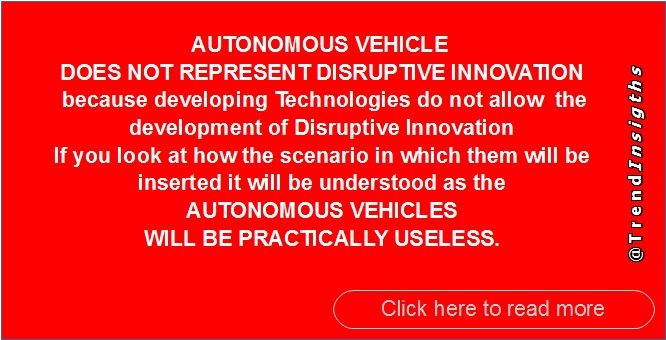
Can Autonomous Vehicles be successful products in the current Disruption Market?
Short Aswer:
AUTONOMOUS VEHICLE
DOES NOT REPRESENT DISRUPTIVE INNOVATION
<see Why developing technologies are incompatible with disrutpive innovation>
And more generally
Hi-techs (developing Technologies)
do not allow
the development of Disruptive Innovation
.
Unfortunately it is a condition with which it is not possible to reach a compromise, due to the intrinsic characteristics of such technologies, such as
● costs: one of the factors that makes disruptive solutions attractive.
● difficulty of being effectively treated by holistic fashion designers <see my Articles on Entrepreneurship>.
● timing: if one senses a need for demand, with the level reached today by “low-tech” it is necessary to wait for the development of technologies.
● the impossibility of adapting to the new forms of disruptive solutions production: there will be a decentralization of the market, with a diffused “production line” and hi-tech cannot be treated in this way <see The Production of the future is not an improvement of the current ones – Beyond the Value chain >
More in-depth answer:
Autonomous Vehicles – like the Artificial Intelligence from which they derive – are currently a “advertising topic” of the current Market that aims to bring Customers into a dimension emotional. <see Does it really exist to the possibility of having an Artificial Intelligence? (the unsustainability of the AI) [1] >
Note that the same is true for Public Institutions, which aim to keep the Citizens in a mental bubble of “futurism” in which one is distracted from the problems created by the current forms of Government.
.
Autonomous Vehicles (and Artificial Intelligence), like many of the technologies still under development:
1) DO NOT REPRESENT A DISRUPTIVE INNOVATION, as Disruptive Innovation is based on already mature technologies (today they are low-tech: Consumer Tech today installed in any low-end SmartPhone, with a ridiculously low cost and easy management by “holistic” disruptive designers).
<see my Articles on New Dimension of Technologies>
2) IT IS NOT A TECHNOLOGY OF WHICH IT HAS THE SAFETY THAT A DAY WILL BE MATURE.
<see The misunderstanding on Artificial Intelligence: why AI cannot be the future of innovation>
Interact also in the scenario, with the need to see the Whole picture: beyond the specific solutions to
The need to see the whole picture: beyond the need for ultra solutions -sophisticated
To understand how Autonomous Vehicles cannot be the Car of the future it is necessary to understand the scenario in which it should fit into the future. <see The need to understand the future scenario to understand the value of disruptive projects >
The fact is that if you can imagine the whole picture ot that scenario, you understand how many elements of it that currently appear to be critical – for which today we try to invent sophisticated solutions like the Autonomous Vehicles – in the near future they will no longer be present.
It must be clear that the problems of a specific sector, such as Mobility, cannot be solved by modifying this element. But, according to the Rules of the Disruptive Innovation <see Decalogue of Rulesof Disruptive innovation>, they are resolved by intervening on the whole system (for example by changing the conception of Mobility to its foundations).
That is, the problems of the various Market sectors (of our Society) will be solved
1) not only by creating a galaxy of new “small solutions” (which in the Disruptive innovation mode are developed bottom-up: by small StartUp or by the Crowd with the new ITC and IoT tools).
2) with an Eco-system in which such specific products can to interact among them (but also with new activities spontaneously developed by Crowd) creating the new form of typical Value of Disrtuptive Innovation <see my Articles on New Value>
.
For these reasons the Autonomous Vehicles – among other problems:
1) would be substantially useless in the Mobility scenario of the near future.
In the new scenario we know conditions radically different from the current ones. For example the possibilities of remote working and the new modes of production and widespread distribution (at Km 0) will drastically reduce the need for travel.
2) the AVs are however unsustainable, because they are conceived with the obsolete mindset of the current Industry 1.0.
One of the factors of unsustainability derives from the inability to start with a truly disruptive approach, for which we focus on technological solutions, lacking the fundamental objective of Innovation: the improvement of the quality of life of the People (of the inhabitants of the city in general, and not of those who use Mobility as drivers of cars or users of public transport).
<see Why Hi-Tec and disruptive innovation are incompatible (the “Human factor”)>
From a more purely technological point of view, one of the problems of the Autonomus Vehilce is to be an electrified car, and therefore to inherit most of the defects of the latter (weight and consumption, space requirement, etc.).
As illustrated in other Articles, it is more likely that the new Electric Vehicles will be developed by Joint between Electronic Companies and bycicle manufacturers, than in the Automotive sector.
.
Of course many of the features now tested on Autonomous Veichles can be used in new types of Vehicles, but without them being made totally autonomous (such as, for example, functions for redistributing the fleet) see my Project LiteMotive: the new future of Mobility>
Autonomous vehicles can also be used in specific contexts, such as micro-shuttle services managed by local communities (in Crowdsourcing mode) to cover the last sections not covered by public transport (trains, couriers).

